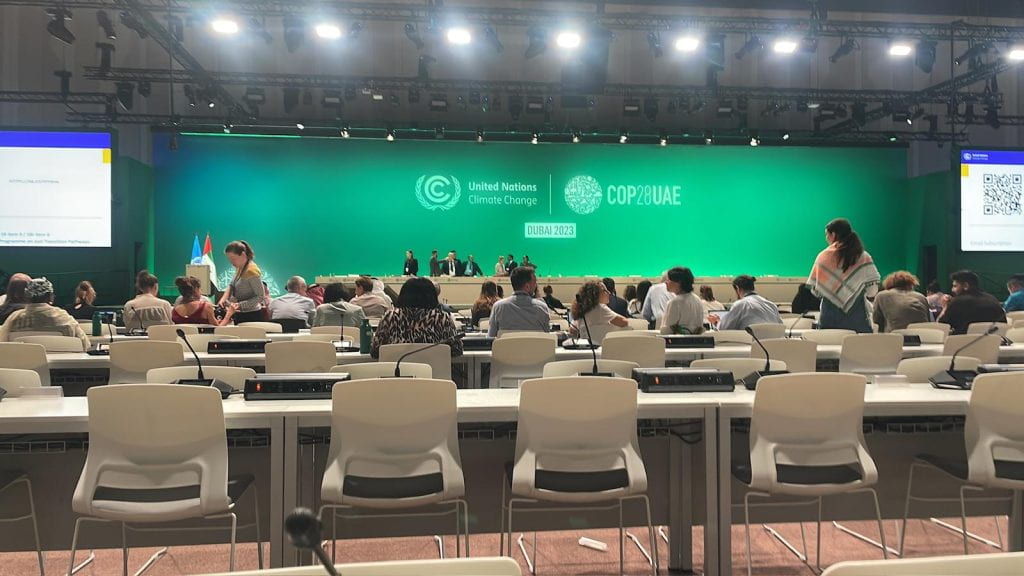
Every year, the official UN climate summits are getting bigger. In 2021 at COP26 in Glasgow there were around 40,000 participants, COP27 in 2022 in Sharm el-Sheikh had 50,000.
But this year blew all previous records out of the water. More than 97,000 participants had badges to attend COP28 in Dubai in person. This raises questions about who is attending COPs and what they are doing there, who gets their voices heard and, on a more practical note, how this affects the negotiations.
For those not familiar with the COP setup, there are two “worlds” that exist side by side. One is the negotiations, which are run under the UN’s climate change body the UNFCCC, and the other is a very long list of talks and social events. These take place in pavilion exhibition spaces and are open to anyone attending, in contrast to the negotiations which are often closed to the media and sometimes closed to observers.
There is a stark difference between these worlds, with pavilion spaces featuring elaborate and inviting settings, particularly if they are well funded, while negotiations often happen in windowless rooms.
A growing sense exists among those invested in the “traditional” side of the COPs that many delegates have no intention of observing the climate talks themselves, and instead spend their time networking in the pavilions.

In terms of who attends, at COP28 there were around 25,000 “party” (country) delegates, 27,000 “party overflow” delegates (usually guests, sponsors, or advisors), 900 UNFCCC secretariat members (who run the COPs), 600 “UN overflow”, and 1,350 from “specialised agencies” such as the World Health Organization or World Bank and their overflows. That makes up just under 55,000 or half of the attendees.
The rest are intergovernmental organisations (2,000), UN Global Climate Action award winners (600), host country guests (5,000), temporary passes (500 – many issued to big private companies), NGOs (14,000 – including one of us, as part of a university delegation), and media (4,000). This is according to the UNFCCC, which places the number of attendees closer to 80,000.
The “party overflow” badges are particularly concerning. The number of delegates connected to the oil and gas industries has quadrupled from last year to around 2,400, many of whom were invited as part of country delegations. As another example, meat industry representatives became part of Brazil’s delegation, while dairy associations organised official COP side events. In the official programme, the Energy and Industry, Just Transition, and Indigenous Peoples Day featured more events by industrial giant Siemens than by indigenous people.
Practically speaking, huge numbers cause problems – this year for example there were delayed meetings, long queues, and several negotiation rooms were beyond capacity with observers and even party delegates asked to limit their numbers and leave.
Even with access to an observer badge, there is little one can contribute to negotiations. The negotiating positions are decided long before the COPs begin, and observers are rarely permitted to speak in negotiations. In addition, a lot of the negotiations are either conducted behind closed doors (called “informal-informals” with no access for the UN or observers) or even in the corridors, where negotiators meet informally to cement positions. The negotiations you can (silently) observe are usually a series of prepared statements, rather than a discussion.
So if COPs are too big and bloated, what is the alternative?
Smaller and more online
One alternative is being a virtual delegate, which one of us tried. This year’s COP trialled live streams and recordings of some of the negotiations, side events and press conferences on an official UNFCCC virtual platform for the first time. The option is a long overdue, but welcome addition. It reduces travel emissions and makes it more accessible, for instance for people with caring responsibilities and others who are unable to travel (or perhaps who refuse to fly).
Some technical teething problems are to be expected. Yet when we queried why the virtual platform didn’t livestream many of the sessions, the COP28 support team pointed us to the official COP28 app. Our employer, the University of Bristol, had advised us not to download the app because of security concerns, which again raises serious issues around transparency and accountability in UNFCCC spaces, as well as freedom of speech and assembly in COP host countries.
Not being there in person also has downsides. As a virtual observer, it’s harder to judge the atmosphere in a negotiation room, to stumble upon and observe spontaneous negotiations happening in corridors, or participate in or observe protests. While indigenous voices were rarely heard in the livestreamed negotiations and events, the Indigenous People’s Pavilion offered a chance to hear them – but only if you were in Dubai. The virtual alternative is a good option to observe negotiations, but it means missing out on some of the civil society lifeblood of COP.
Another option is to limit access to COPs – for example, limiting the in-person negotiations only to the most vital participants. Party tickets could be limited, with lobbyists from fossil fuel industries tightly controlled and priority given to climate victims, indigenous communities and underrepresented countries. Side events and pavilions could take place a few months before the COPs, increasing the chances of influencing negotiations, since positions are cemented early. There is no reason these only need to happen in one place once a year, there could be regional meetups in between, allowing for formal contact more often.
These issues of access, transparency and influence have serious implications on negotiation outcomes and climate action. After undergoing various draft iterations that offered options ranging from “no text” to “phasing out” or “down” fossil fuels, this year’s final agreement does not include a commitment to phasing out. This watered-down agreement reflects the inability of indigenous peoples and the most climate vulnerable countries to meaningfully participate in the negotiations – future COPs must trim down to make their voices heard.
This blog is written by Cabot Institute for the Environment members, Drs Alix Dietzel, Senior Lecturer in Climate Justice, University of Bristol and Katharina Richter, Lecturer in Climate Change, Politics and Society, University of Bristol.
This article is republished from The Conversation under a Creative Commons license. Read the original article.


